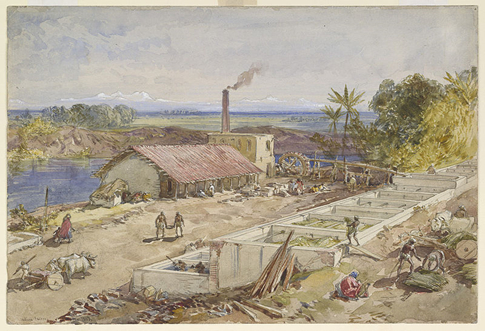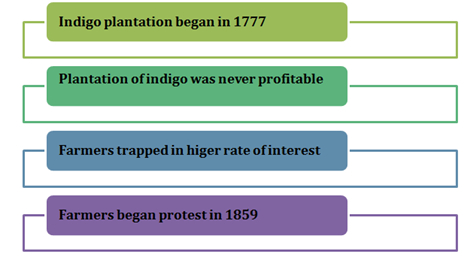

The plantation of Indigo made a critical situation for the farmers as this process of cultivation created an issue in the soil. Once the farmers started to grow indigo, they would face issues in planting other crops. British merchants on the other hand pushed the farmers to plant indigo as they made a huge profit by selling indigo in the international market.
The cultivation of Indigo started in Bengal for the first time in 1777. A Frenchman named Loius Bonnaud introduced the cultivation of indigo to the subcontinent of India. He was the first planter of Indigo in Bengal to start the cultivation in Goalpara and Taldanga in the Hoogly district of Bengal.

Indigo Factory Bengal
William Simpson, Public domain, via Wikimedia Commons
During the period when the Bengal Nawab went under the control of the British East India Company (E.I.C), the plantation of indigo increased in the lands of Bengal. Due to higher profitability and the commercial perspective of selling indigo in the international market, the period was considered the European demand for a blue day.

The aspects of Revolt of Indigo
The planters also get benefits from the policy made by the government in favour of them. Due to the British ruler’s policy conducted in 1833, planters got more opportunities to deal with the farmers regarding the plantation of indigo. Zamindars in that period showcased their support to the planters.
Consequently, farmers showcased their protest as they no longer wanted to plant indigo on their land. This resulted in the indigo revolt in India by the farmers during the period of 1859-60.
The followings are the features of the indigo revolt in Bengal in the 19th century that is also considered the movement of the peasants in Indian history −
Indigo plantation happened in Bengal for the first time in 1777.
Indigo was recognised as a worldwide popular material. The European markets had extreme demand for blue dye that could be managed with the plantation of Indigo as the trade made the British merchant profitable business.
British merchants were forcing the planters to cultivate indigo instead of food crop.
Farmers who defuse to plant indigo cultivation resorted to illegal terms like burning crops and looting, kidnapping anyone of family members of that farmer, and other activities that can persuade the farmer to grow indigo.
The revolt of Indigo was considered a peasant movement and the rising protests against the planters of indigo occurred in 1859 in the Chaugacha village of Nadia, Bengal.
The planters of indigo aimed to accumulate the rights of land in different ways so they can pressurise the farmers to cultivate indigo only. They took the lands that remained unoccupied on permanent or temporary leases from the Bengal Zamindars. Planters also gained the Zamindari rights to ensure that indigo cultivation never stops. Many farmers became abandoned due to the pressure of indigo plantations in their lands occupied by the planters.
The followings are the causes behind the revolt of indigo −
The planters persuaded the farmers to cultivate indigo instead of food crops. They also give loans with a higher rate of interest that are named dadon.
Planters pay only 2.5% of the market price of indigo which was not profitable for the farmers.
Farmers often faced torture from the planters as they were threatened with a property destruction process for refusing to cultivate indigo on their lands.
Planters had support from both Zamindars and policies derived from the government.
The unethical movements followed by the indigo planters were the primary reason behind the conduction of the indigo revolt.
The complete unity of the Muslim and Hindus was considered the success of the movement. The farmers showcased protests against the planters as well as zamindars in a mass led to one of the greatest significance.
The revolt of indigo was operated by newspaper campaigns, held group meetings, recruited memoranda on farmers’ resentments, and helped them in legal conflicts. The government reacted to the Revolt as more rhythmic than and not as severe as it had existed in the case of civil revolutions and tribal revolts.
The revolt of indigo was mostly non-violant and passive. Due to the protest of the Bengal farmers, the planters were forced to move to Bihar for the cultivation of Indigo. In the 19th century, the supply of indigo was damaged worldwide (Prasad, 2018). The colonial authorities of the British government construct the Indigo Commission in 1860 and made an end to the repressions of the planters of indigo in Bengal.
Indigo planters at that period offered loans to the farmers for the process of cultivation. Farmers were about to spend their whole life to repay the loan amounts and were forced to continue the cultivation of indigo. Planters only pay around 2.5% of the market price to the farmers. Planters of indigo used to threaten the farmers with property or mortgages. During the summer, thousands of riots started to refuse growing indigo for the British planters.
Q.1. When the revolt of indigo was began?
Ans. The revolt started in the Gobindapur and Chanugacha villages in Krishnanagar. Bishnucharan Biswas and Digambar Biswas was the leader of the first protest against the planters of indigo in Bengal in 1859.
Q.2. In which districts did indigo plantation occur in Bengal?
Ans. The indigo planters did not refer to crop the food items that are recognised as cropping indigo for more profits. The plantation of indigo increased rapidly in different districts of Bengal such as Bankura, Birbhum, North 24 Parganas, and Jessore (currently known as Bangladesh).
Q.3. Why indigo had a huge demand in the global markets?
Ans. Indigo blossoms were native to regions of both tropical and subtropical across the international market. Due to the rare availability of the indigo plantation, the international market for blue dye often had the need for indigo.